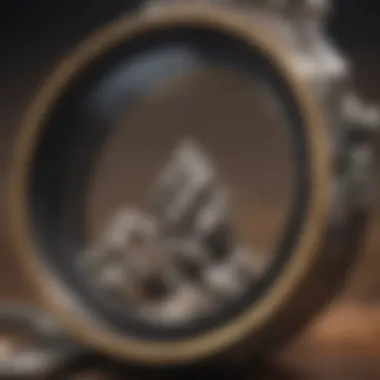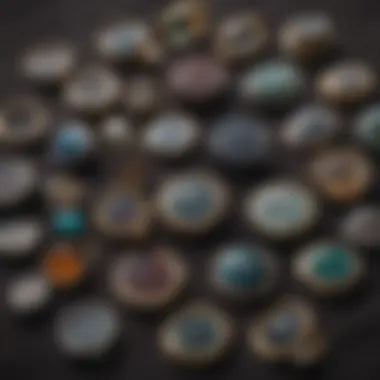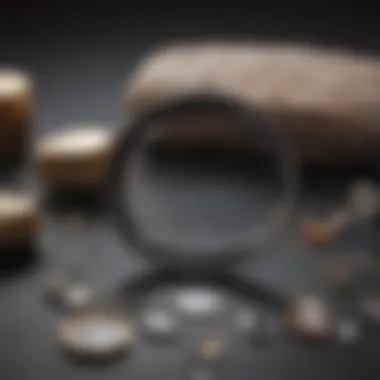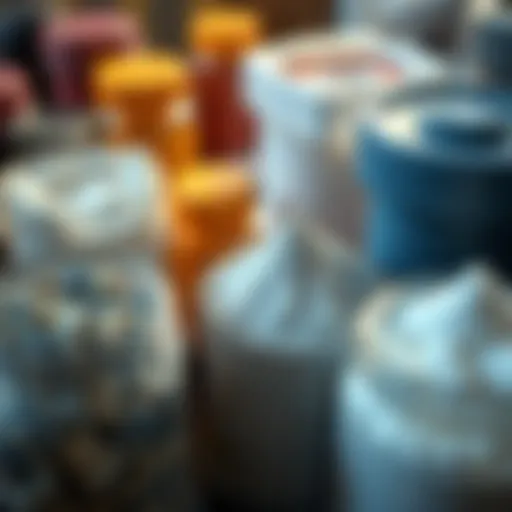Understanding Jewelry Loupe Magnification Insights


Intro
Understanding jewelry loupes and their magnification capabilities is not merely an academic exercise; it serves as a fundamental tool for anyone in the realm of jewelry appraisal, gemology, and even hobbyist collectors. A jewelry loupe is more than just a magnifying glass; it acts as a window into the fine intricacies of gemstones and metals. By employing a jewelry loupe, collectors and professionals can identify flaws, assess quality, and appreciate the artistry that goes into each piece of jewelry.
The relationship between magnification power and optical clarity is crucial. Opting for a loupe without understanding these factors can lead to misjudgments and poor assessments. In an age where counterfeit items are prevalent, particularly in the precious stones market, having a reliable tool becomes indispensable.
This comprehensive guide intends to shed light on the history, types, and uses of jewelry loupes, equipping readers with essential knowledge that enhances their experience and proficiency within this fascinating field. Let's delve deeper into the history and origins of these indispensable tools.
Prelude to Jewelry Loupes
The realm of jewelry inspection is often overlooked yet profoundly essential to both collectors and professionals. Jewelry loupes serve as critical tools in this space, enhancing the ability to assess gems and intricate designs meticulously. These small magnifying glasses can reveal fine details that would otherwise remain hidden to the naked eye. Understanding jewelry loupes not just aids in identifying quality but also enriches the overall appreciation of jewelry artistry.
Definition and Purpose
A jewelry loupe is essentially a portable magnifier, allowing users to inspect gems and designs closely. Primarily, it serves two essential purposes: detection of flaws and confirmation of authenticity. Different magnification levels help users determine characteristics such as clarity, color distribution, and inclusions in gemstones. For enthusiasts, having a quality loupe on hand becomes indispensable for evaluating potential purchases when scouring marketplaces.
Moreover, loupes can significantly impact the decision-making process in buying or selling jewelry. For instance, a seasoned diamond dealer might rely on a loupe to observe tiny details that could alter a gem's value. As such, understanding how to effectively utilize these tools becomes vital.
Historical Context
Jewelry loupes have a rich lineage that traces back centuries. The roots of this handy tool can be found in older magnifying glasses, with the first recorded use during the Renaissance. Back then, artisans employed rudimentary versions to examine the minute details of their creations. As craftsmanship evolved, so did the technology behind loupes.
In the 19th century, the development of glass manufacturing techniques resulted in better quality lenses and more refined tools for the gemology community. It was during this period that the modern loupe as we know it began to take shape. The introduction of specialized gemological loupes equipped with varying magnification powers made it easier for gemologists and jewelers alike to assess stones with greater accuracy.
"A loupe is more than just a magnifier; it is a window into the elegance and intricacies of jewelry design that otherwise remain unnoticed."
Today, the evolution continues, blending traditional craftsmanship with contemporary technology. Modern loupes come in various forms, not just simple handheld glasses but also digital variants. Each advancement makes it easier for both hobbyists and professionals to delve deep into the beautiful complexities of gemstones and precious metals, ensuring that the legacy of jewelry inspection continues to thrive.
Types of Jewelry Loupes
When it comes to evaluating fine jewelry and gemstones, the type of loupe can make a world of difference. Each variety serves unique purposes, offering specific benefits that cater to different needs—from gemologists to hobbyists. Understanding these various types can help you choose the right tool for your requirements, ensuring that you make the most of its magnifying capabilities. Let's explore some common types of jewelry loupes:
Basic Handheld Loupes
Basic handheld loupes are often the first choice for many enthusiasts. These loupes typically provide magnifications between 10x to 20x, which is sufficient for most basic examinations of gemstones. They are usually small and lightweight, making them incredibly portable. Their simplicity permits ease of use, particularly for those who are just starting in the field of gemology.
"A basic loupe is like a trusty old friend; it gets the job done without any bells and whistles."
Pros:
- Easy to Use: They require minimal technical knowledge.
- Affordable: Generally, basic models are budget-friendly.
- Widely Available: You can find them at many jewelry and hobby stores.
Cons:
- Limited Magnification: For higher precision, they may fall short.
- No Advanced Features: Lacks additional lighting or digital options.
Foldable Loupes
Foldable loupes offer a blend of convenience and enhanced usability. As the name suggests, these loupes can fold into a compact size, making them a great option for people on the go. Many foldable loupes come with a built-in eyepiece and typically provide similar magnifications to handheld loupes, though some can reach higher levels.
Their design often appeals to collectors who appreciate practicality alongside functionality.
Benefits:
- Space-Saving: Their compact size makes them easier to carry around.
- Variety in Magnification: Some models come with interchangeable lenses, improving versatility.
Considerations:
- Durability: Depending on the craftsmanship, some may be less sturdy than fixed models.
Digital Loupes
Digital loupes represent a leap forward in magnification technology. These modern tools often include built-in cameras that allow for capturing high-resolution images, which can be incredibly useful for documentation and analysis. With magnifications often surpassing traditional options, they are ideal for professionals who require detailed insight into the jewelry or gemstones they are evaluating.
Features:
- Display Options: Many digital loupes have screens for easy viewing.
- Data Storage: Built-in memory allows for saving images and videos for later reference.


Drawbacks:
- Price Point: They are usually more expensive than their non-digital counterparts.
- Power Needs: Battery dependence can be a downside when you're in the field.
Lighted Loupes
Another significant type is the lighted loupe, which employs built-in illumination to enhance viewing conditions. This feature is particularly valuable when examining darker stones or complex details in gemstones, where the natural light may not suffice.
Advantages:
- Improved Visibility: Better clarity in poorly lit situations.
- Versatility: Useful across a range of scenarios—from home use to professional evaluations.
Challenges:
- Light Source: Requires batteries or a charging mechanism, which may pose logistical challenges.
- Bulkiness: Some models can be bulkier than traditional handheld loupes, making portability a concern.
By understanding the variety of jewelry loupes available, you can select the right tool that meets your specific needs—whether you’re a gemologist assessing the authenticity of a stone, or a collector wanting to appreciate the intricate details of your latest find.
Magnification Power Explained
Magnification power serves as one of the cornerstones of using jewelry loupes effectively, playing a vital role in precision evaluation. Understanding how various levels of magnification work helps users—from seasoned gemologists to novice collectors—appreciate and make informed choices when examining their treasures. It’s not just about peering closely; it’s about unlocking a wealth of details hidden to the naked eye.
Understanding Magnification Levels
Magnification refers to how many times larger the object appears compared to its actual size. Jewelry loupes typically offer a range of magnification levels—the most common being 10x, 20x, and even 30x.
- 10x Magnification: This level is ideal for general inspections, like spotting inclusions in gemstones or identifying surface imperfections.
- 20x Magnification: When a closer look is required, 20x allows you to see more intricate details, including gemstone clarity and facet precision.
- 30x Magnification: This higher level generally helps professionals in serious gemological assessments, providing an exhaustive view of gemstones, which is especially beneficial in lab settings.
Each level has its specific applications, so understanding the available magnifications allows collectors to select the right loupe for their needs.
Common Magnification Ratios
Magnification ratios are often defined in fractions. For instance, a 10x magnification means the object appears ten times larger. However, loupes come with various ratios catering to different needs:
- 3x to 5x: Often found in cheaper models, suitable for casual hobbyists who just want a general view.
- 10x to 15x: This is the sweet spot for collectors wanting a more detailed exploration, striking a balance between ease of use and seeing enough detail.
- 20x and above: More suited for professional examination. While they offer depth, they can be challenging to hold steady when focused on a tiny object.
The right choice depends on the intended application and the user’s skill level. It’s vital to keep in mind that higher magnification does not always equate to the best viewing experience if the user struggles to keep the loupe stable.
Impact of Magnification on Jewelry Evaluation
The power of magnification significantly impacts jewelry appraisal and evaluation. Greater magnification reveals characteristics of the stone that are otherwise indistinguishable.
- Clarity: Magnifying a diamond at 10x can help identify minute inclusions, which are critical to determining the quality and value of the stone.
- Color: Under higher magnification, subtle color differences in gemstones can help in distinguishing between real and synthetic stones. Such variations can be crucial in grading and valuation.
- Cut and Polish: Inspecting the facets and surface finish under a loupe can highlight craftsmanship quality, which again plays a pivotal role in the gem's final worth.
"True appreciation of jewelry lies in its details; the beauty often hides beneath the surface, waiting for a keen eye to discover it."
Magnification, therefore, does not merely enhance visibility. It elevates the jewelry evaluating process, making it a critical skill for any serious gem enthusiast or collector. By carefully considering magnification power alongside its implications, one can greatly enhance their understanding of the gemstone world.
Optical Quality of Loupes
When it comes to assessing jewelry, the clarity and precision of the loupe can make or break your evaluation. The optical quality of jewelry loupes plays a crucial role, influencing not just the way you view gems, but also your ability to discern their unique characteristics. High optical quality allows for true-to-life color representation and sharper details, which are essential for any collector or gemologist.
Lens Types
The lens is the heart of any loupe. Different types of lenses can drastically impact your viewing experience.
- Convex Lenses: These are the most common in jewelry loupes, as they allow for greater magnification with a wider field of view. They are especially effective for inspecting stones, revealing their cut and clarity.
- Aspheric Lenses: These lenses offer less distortion compared to standard convex lenses, making them ideal for those who demand precision. They can be a bit pricier but worth every penny for professionals.
- Bifocal Lenses: Useful for those who need to look at both high magnification and regular vision. They combine the best of both worlds, eliminating the need for switching instruments.
Each lens type has its pros and cons, and understanding these can sway your purchasing decision toward the loupe best suited to your needs.
Aperture and Field of View
Aperture size is another vital aspect to consider when selecting a loupe. A larger aperture allows more light to enter, resulting in a brighter image. Conversely, a more narrow aperture can give you a deeper depth of focus but with less brightness. Here’s what to keep in mind:
- Field of View: This refers to how much of the object you can see at one time through the loupe. A broader field makes it easier to inspect larger rocks, while a tighter field provides greater detail.
- Depth of Field: A loupe with a good depth of field allows you to maintain clarity across different focal lengths—helpful when switching between inspecting facets and overall stone quality.
Balancing both factors often influences how well you can assess a piece of jewelry holistically and accurately.


Importance of Coating and Glass Quality
Lastly, the quality of the glass used and any coatings applied to the lenses can’t be overlooked. High-quality glass will reduce distortion and enhance overall clarity. Here’s why it matters:
- Anti-Reflective Coating: This minimizes glare and reflections, allowing you to see every detail, even in bright light. It’s often the difference between a good view and a great one, especially under harsh conditions.
- Scratch Resistance: Investing in loupes with durable coatings can save you from frequent replacements. Since jewelry assessments can involve grime and dust, having a lens that stands up to cleaning is key.
Collectors and gemologists alike should ensure their loupes meet high optical standards to maintain the integrity of their findings.
"The quality of your loupe transcends mere functionality; it elevates your ability to see what others cannot."
In the world of gemology, your tools are just as important as your knowledge. Taking the time to understand these optical qualities can significantly enhance your expertise and enjoyment in assessing jewelry.
Using a Jewelry Loupe Effectively
When it comes to examining jewelry closely, using a loupe can make all the difference. It's not just about having the tool; knowing how to use it effectively is crucial. An effective loupe experience depends on understanding how to view and position the loupe for optimal results. This ensures that every intricate detail of the gem's characteristics is visible, allowing for informed evaluations, especially for those who collect rocks and fossils.
Proper Techniques for Viewing
To truly appreciate the beauty of a stone, one must master the art of viewing with a loupe. Proper techniques elevate the overall experience. Here are a few essential tips:
- Stabilize your hands: For clear visibility, find a steady support for your hands. Resting elbows on a firm surface can assist.
- Lighting is key: Ensure that your viewing area is well-lit. Natural light works wonders; however, using a lighted loupe can help illuminate darker stones.
- Close one eye: This reduces distractions and enhances focus on the details you wish to observe. It’s an old trick but effective.
- Adjust distance gradually: Move the loupe closer to your eye until you find a comfortable focus distance. Each gem may require slight adjustments.
All these techniques can lead to a clearer understanding of the gemstone's quality and any imperfections it may have.
Positioning the Loupe
Correct positioning of the loupe can mean the difference between seeing the gem’s qualities or missing crucial details. Below are some positioning considerations:
- Hold it at the right angle: A tilted loupe can obscure your view. Hold it perpendicular to the gem, ensuring the lens is parallel to the surface.
- Distance matter: Vary the distance according to the magnification level. For higher magnifications, such as 10x, the loupe should be closer to the eye.
- Anchoring the object: If possible, steady the jewelry piece on a flat, cushioned surface. This prevents the stone from wobbling, ensuring a clearer look.
Using these methods effectively maximizes the loupe’s potential and allows one to not only evaluate the quality of the piece but also to enjoy the fine craftsmanship present in each gemstone.
Caring for Your Loupe
Caring for your loupe is a crucial aspect that can significantly extend its lifespan and maintain its performance. Just like any tool of importance, such as a finely-tuned instrument or a prized piece of equipment, a loupe demands proper attention and maintenance. If it's treated carelessly, it may not provide clear images, rendering it nearly useless for detailed inspections. For rock and fossil collectors, a dependable loupe can mean the difference between recognizing a gem’s subtle features and overlooking them. Understanding the best methods for cleaning and storing your loupe can make a marked difference.
Cleaning Methods
Keeping your loupe clean is fundamental. Dust, fingerprints, and other debris can obscure the view, hampering your ability to see the finer details of gemstones or collectibles. Here’s how to ensure your loupe maintains clarity:
- Use a Microfiber Cloth: A soft, lint-free microfiber cloth is ideal for wiping the lens. Avoid paper towels or other rough materials that could scratch it.
- Lens Cleaning Solutions: There are many products specifically made for lens cleaning. Here’s how to use them:
- Avoid Abrasive Materials: Steer clear of any materials that might scratch the lens, such as rough cloths or cleaning solutions that contain alcohol or strong solvents.
- Regular Inspection: Make it a routine to check the lens for dust or grime before each use. A clean loupe ensures you won’t miss those valuable details.
- Gently wipe the lens in a circular motion, applying minimal pressure.
- For stubborn smudges, lightly moisten the cloth with water or a specialized lens cleaner.
- Spray a small amount on the microfiber cloth, never directly onto the lens.
- Follow the same wiping technique as mentioned before.
"Remember, a clear lens leads to clearer observations, which is the heart of gemology and collecting."
Storage Best Practices
Proper storage of your loupe can protect it from damage and unnecessary wear. A few best practices can keep your loupe in peak condition:
- Choose a Dedicated Case: Use a protective case or pouch that's padded. This prevents scratching and keeps it safe from impacts. A small, hard-shell case is often preferable.
- Keep Away from Direct Sunlight: Prolonged exposure to sunlight can deteriorate the materials of your loupe. Store it in a cool, dry place away from light.
- Temperature and Humidity Control: Extreme temperatures and humidity levels can adversely affect your loupe’s materials. Store it in a stable environment, ideally around room temperature.
- Avoid Cluttered Spaces: When placing your loupe, ensure it’s not mixed with other tools or items that could scratch or damage it.
Taking good care of your loupe enhances its reliability and performance. Regular cleaning and appropriate storage not only safeguard your investment but also encourage you to use this invaluable tool in your hobby or profession.
The Role of Loupes in Gemology
Exploring the role of jewelry loupes in gemology reveals a fascinating intersection of art and science. For enthusiasts, collectors, and professionals alike, these simple magnifying tools serve as crucial instruments in visual analysis. At their core, loupes help in the assessment of gemstones, offering a lens through which one can appreciate the intricate details that elevate them beyond mere rocks.
Identifying Gem Characteristics
When examining a gemstone, identifying its characteristics is paramount. Color, clarity, cut, and carat weight�—commonly known as the Four Cs—come into play, but that's just the tip of the iceberg.
- Color: Loupes can reveal subtle hues and variations that may not be visible to the naked eye. It's not uncommon for professional gemologists to discern slight color zoning, which can influence the gem's value.
- Clarity: Tiny inclusions or surface blemishes can drastically alter a gem’s grade. A loupe's magnification allows gemologists to closely inspect these imperfections, contributing to a more accurate appraisal.
- Cut: The precision of the cut can sometimes be appreciated only under magnification. A loupe helps in examining facets and angles, which are crucial for light performance in gemstones.
- Carat Weight Measurement: While loupes don't weigh gems, they assist in observing gemstones’ geometry, which influences their perceived size versus actual weight.
In essence, investing time with a loupe can reveal a wealth of knowledge about a gemstone's identity, potentially guiding purchasing decisions for both collectors and casual buyers.


Evaluating Authenticity and Value
Beyond identifying characteristics, loupes hold significant importance in evaluating authenticity and value. The gemstone market often encounters imitations and treatments that can trick even seasoned eyes. Here’s where a loupe can be a game changer:
- Authentication: A loupe is instrumental in distinguishing between natural and synthetic gems. For example, the presence of gas bubbles in certain synthetic stones can be spotted easily through a loupe, providing insight into the gemstone's true origin.
- Identifying Treatments: Various treatments can enhance a gemstone's appearance but may also diminish its intrinsic value. For instance, a heated ruby may look stunning, but under magnification, traces of artificial enhancement might surface, shedding light on its genuine worth.
- Market Value Assessment: Understanding a gem's quality through careful evaluation enables buyers to negotiate better and sellers to price fairly. This directly impacts both collectors and dealers, ensuring that transactions are informed and reliable.
"The key to navigating the complex world of gemstones is understanding what lies beneath the surface. A loupe is not just a tool; it is a gateway to deeper knowledge about every gem you encounter."
Loupes and Collectors' Communities
The bond between loupes and collectors' communities is exceptionally vital for several reasons. At its core, the jewelry community, whether that consists of seasoned gemologists or budding enthusiasts, thrives on shared knowledge. Loupes serve as a bridge that connects these individuals, as everyone comes with their distinct experiences and insights on how to utilize these vital tools effectively.
When collectors gather—be it informally at a local show or within the confines of a structured club—loupes are typically the stars of the show. Having the right loupe can spark a discussion about various techniques and preferences, allowing individuals to share their personal journeys with magnification. This exchange not only enriches one's skill set but also enhances understanding of the gems themselves. The nuances of how different magnifications reveal unique details about stones, like cleavages or inclusions, become topics of passionate dialogue.
"A loupe opens up a world hidden from the naked eye, and sharing what we see broadens our horizons."
Sharing Knowledge and Techniques
Knowledge sharing within communities cultivates a supportive environment where both novice and expert collectors can learn from each other. Many collectors have their unique ways of using loupes to assess gem quality or detect signs of enhancement. These methods can vary greatly—one collector might swear by a 10x magnification for inspecting diamonds, while another might prefer a lower magnification for evaluating softer gemstones like opals, where inclusions can be less obvious.
Techniques also extend beyond just viewing; they encompass how to properly hold the loupe, adjusting the distance for optimal focus, and strategies for lighting. Collectors might unite to demonstrate their techniques, creating workshops that can help refine skills for all attendees. This, in turn, encourages more effective evaluations of jewelry, which is especially beneficial in an era where online purchases are becoming more prominent.
Online Resources and Forums
The internet has further assisted in making resources widely accessible. Online forums and social media groups dedicated to gemology and jewelry often have threads focused specifically on the use of loupes. Websites like reddit.com foster engagement where users share their insights, reviews, and recommendations about various loupe models, aiding fellow collectors in making informed choices.
In addition, platforms like facebook.com host specialized groups where veteran collectors offer tips on effective loupe usage—anything from the optimal magnification for different gem types to maintenance practices that prolong the life of these tools. Automating the process has made the collector community more inclusive; those who might otherwise feel intimidated or left out can now participate from the comfort of their homes.
Innovations in Loupe Technology
In the realm of jewelry appraisal and gemology, innovations in loupe technology have revolutionized how enthusiasts and professionals alike view and evaluate pieces. Advancements in this field not only enhance the clarity and precision of observations but also broaden the accessibility of these tools to collectors and hobbyists. Understanding these innovations can significantly shape the way one appreciates the intricate details embedded within their jewelry, pushing beyond simple visual inspections to more nuanced analyses.
Advancements in Digital Imaging
The introduction of digital imaging technology has been nothing short of transformative for jewelry loupes. Gone are the days when one relied solely on magnification through glass lenses. Now, digital loupes come equipped with high-resolution cameras that produce detailed images of gemstones and jewelry. The benefits of this technology are manifold:
- Increased Visibility: Digital imaging allows users to view intricate details, such as inclusions or flaws, with unprecedented clarity. This added precision helps in authenticating gems and assessing their value with greater accuracy.
- Documentation and Sharing: With the ability to capture images or videos, collectors can document their treasures. This is especially advantageous when sharing with communities or for insurance purposes. A quick snap with a digital loupe can solidify provenance and support claims of value.
- Adjustable Magnification: Some digital loupes offer adjustable settings, allowing users to zoom in and out as needed. This feature provides flexibility when examining various pieces without the hassle of switching devices.
Integrating Smartphone Lenses
The rise of smartphones has paved the way for remarkable integrations into the loupe market. Many manufacturers have begun designing lenses that fit onto smartphones, transforming these ubiquitous devices into powerful inspection tools. This integration reflects a broader trend towards convenience and portability in technology. The advantages of smartphone lens attachment are significant:
- Portability: Consumers often walk around with their phones in their pockets. Combining smartphone capabilities with loupe functionality ensures that collectors have their tools ready at a moment's notice, without adding extra weight to their collections.
- User-Friendly Experience: Most people are familiar with their smartphones, so adapting to a new loupe requires minimal learning. The user experience is streamlined since many already understand how to navigate apps for capturing images or videos of their jewelry.
- Enhanced Features: Modern smartphones boast features such as image stabilization and editing capabilities. When a loupe is coupled with a smartphone lens, it allows users to not only capture stunning close-ups but also to manipulate those images right on their phones. By enhancing images, hobbyists can analyze them for further study or share them seamlessly through social networks.
By embracing new innovations in jewelry loupe technology, collectors are not just enhancing their viewing experiences, but also embracing a culture of learning, sharing, and connecting with others in the gemology community.
End
In wrapping up our discussion on jewelry loupes, it's clear that understanding magnification power and its implications is key for anyone diving deep into gemology or jewelry appraisal. The importance of jewelry loupes cannot be overstated; they serve as indispensable tools for both enthusiasts and professionals alike. It’s not just about having a closer look; it’s about elevating one’s appreciation and discernment of fine jewelry.
Key elements to highlight include:
- Enhanced Observation: Jewelry loupes allow closer examination of gemstones, aiding in spotting inclusions, facets, and other characteristics that define quality and value.
- Authentication Aid: In a world where fakes abound, a loupe can be the differentiator when verifying authenticity.
- Educational Tool: For collectors, learning the intricacies of gemstones through loupes enriches their knowledge base, allowing for informed discussions and decisions.
Additionally, loupes facilitate a more refined understanding of various types of stones. Whether it’s a diamond or an opal, seeing the details magnified can change perceptions and appreciation. A loupe isn’t just a tool; it’s a window into the captivating world of gems.
Summary of Key Points
To summarize the key points covered:
- Jewelry loupes come in various types as outlined; understanding which fits your needs is crucial.
- Magnification levels impact the degree of detail visible during evaluation.
- Optical quality, encompassing lens type and coatings, directly affects usability.
- Proper care and handling maintain the integrity of your loupe, ensuring longevity and effectiveness.
With these understandings, collectors should better appreciate the essential role of loupes in their pursuits, bringing clarity and insight into their gemstone explorations.
Future Directions in Loupe Usage
As we look ahead, the future of loupe usage seems promising. Innovations in technology are paving the way for more versatile tools, such as:
- Smartphone Integration: The emergence of phone-compatible loupes allows for easy sharing of findings and experiences on social media or gemology forums like Reddit or Facebook.
- Digital Enhancements: Improvements in digital imaging open doors to greater details and possibilities for remote evaluations.
Furthermore, as the industry adapts to changing consumer preferences, we might see loupes that integrate augmented reality features, enabling users to visualize aspects of gemstones and jewelry that might typically require deeper expertise.
The landscape of jewelry appreciation is evolving, and staying informed will undoubtedly empower collectors as they navigate these new waters. The future of jewelry loupes is not just an enhancement in viewing – it promises to broaden the horizons of understanding jewelry on multiple levels.



